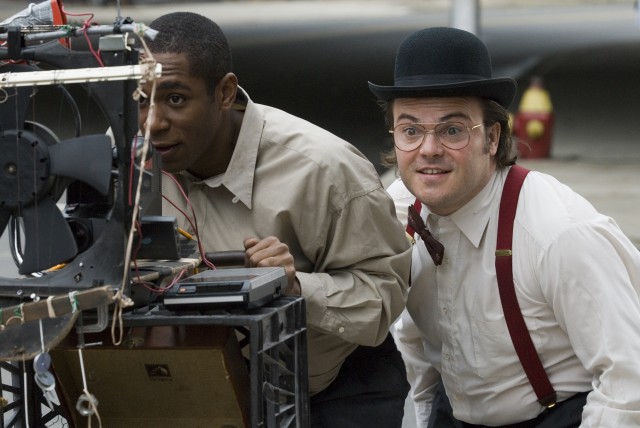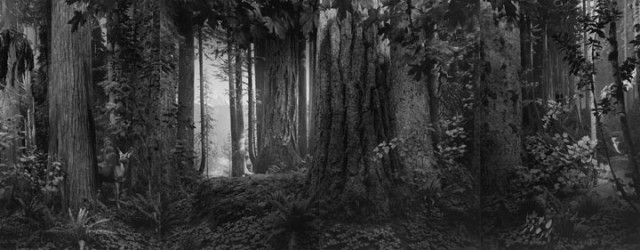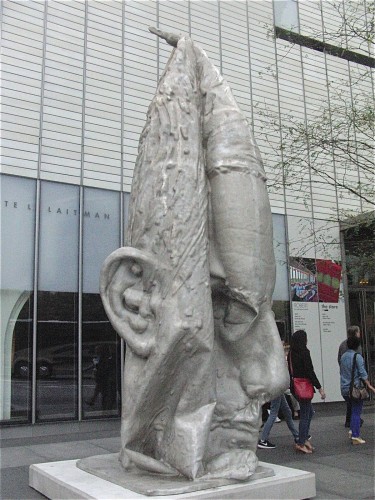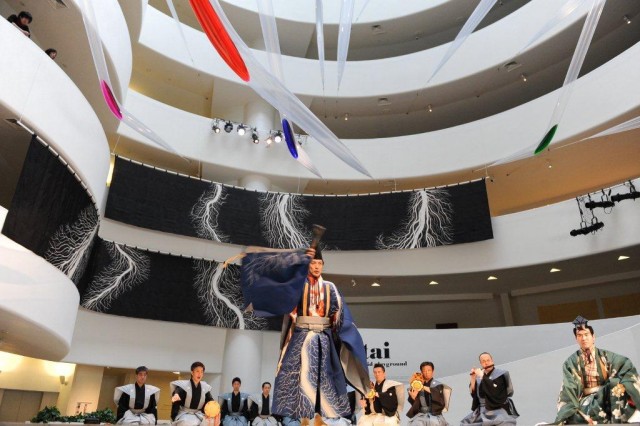BE KIND REWIND (Michel Gondry, 2008)
Museum of the Moving Image
35th Ave. at 36th St., Astoria
Sunday, November 8, 4:30
Series runs through November 8 – December 27
718-777-6800
www.movingimage.us
 When old man Fletcher (Danny Glover) takes off for a week, leaving Mike (Mos Def) in charge of his soon-to-be-demolished video store called Be Kind Rewind (they don’t have any DVDs or recent movies), his most important rule is to “Keep Jerry Out.” Jerry (Jack Black) is a crazy conspiracy theorist who covers himself in metal to ward off alien rays. After a botched attack on the local power plant, Jerry becomes a walking magnet (in a laugh-out-loud hysterical scene) and unknowingly erases all the videos in the store. Taking a page from the Little Rascals plots when Spanky and Alfalfa would suddenly put on a show for some local cause, Mike and Jerry recruit Alma (Melonie Diaz) as they proceed on their very strange attempts at Sweding — making their own versions of such films as Ghostbusters, Rush Hour 2, and Robocop and renting them out as if they were the real thing. Following the brilliant Eternal Sunshine of the Spotless Mind and the extremely strange The Science of Sleep, writer-director Michel Gondry has fashioned a really stupid movie that has an overabundance of heart and charm. Glover and Mos Def are soft and gentle in this Capra-esque comedy, offsetting Black’s hyperactivity. Every time you’re ready to write the film off as being just too silly and ridiculous, something comes along to make you double over in laughter. Be Kind Rewind kicks off the Museum of the Moving Image series “Walkers: Hollywood Afterlives in Art and Artifact,” being held in conjunction with the new exhibition that examines how contemporary artists have used iconic Hollywood imagery in their work, with sculptures, photographs, paintings, videos, drawings, and more by Francis Alÿs, Richard Avedon, Jim Campbell, Gregory Crewdson, Jean-Luc Godard, Douglas Gordon, Isaac Julien, Martin Kippenberger, Guy Maddin, Mary Ellen Mark, Richard Prince, Tom Sachs, Hiroshi Sugimoto, Piotr Uklanski, Pierre Bismuth, and many others. Be Kind Rewind is screening November 8 at 7:00, preceded by Oscar winner Bismuth’s Where Is Rocky II? trailer. Bismuth will introduce the films, then participate in an artist talk with curator Robert M. Rubin afterward. After a break, the series picks up after Thanksgiving, continuing through December 27 with such iconic and influential classics as Dr. Strangelove, Sunset Boulevard, Double Indemnity, Chinatown, Psycho, and The Wild Bunch as well as several cult faves by Maddin, who will be on hand to talk about his latest, The Forbidden Room, on December 12.
When old man Fletcher (Danny Glover) takes off for a week, leaving Mike (Mos Def) in charge of his soon-to-be-demolished video store called Be Kind Rewind (they don’t have any DVDs or recent movies), his most important rule is to “Keep Jerry Out.” Jerry (Jack Black) is a crazy conspiracy theorist who covers himself in metal to ward off alien rays. After a botched attack on the local power plant, Jerry becomes a walking magnet (in a laugh-out-loud hysterical scene) and unknowingly erases all the videos in the store. Taking a page from the Little Rascals plots when Spanky and Alfalfa would suddenly put on a show for some local cause, Mike and Jerry recruit Alma (Melonie Diaz) as they proceed on their very strange attempts at Sweding — making their own versions of such films as Ghostbusters, Rush Hour 2, and Robocop and renting them out as if they were the real thing. Following the brilliant Eternal Sunshine of the Spotless Mind and the extremely strange The Science of Sleep, writer-director Michel Gondry has fashioned a really stupid movie that has an overabundance of heart and charm. Glover and Mos Def are soft and gentle in this Capra-esque comedy, offsetting Black’s hyperactivity. Every time you’re ready to write the film off as being just too silly and ridiculous, something comes along to make you double over in laughter. Be Kind Rewind kicks off the Museum of the Moving Image series “Walkers: Hollywood Afterlives in Art and Artifact,” being held in conjunction with the new exhibition that examines how contemporary artists have used iconic Hollywood imagery in their work, with sculptures, photographs, paintings, videos, drawings, and more by Francis Alÿs, Richard Avedon, Jim Campbell, Gregory Crewdson, Jean-Luc Godard, Douglas Gordon, Isaac Julien, Martin Kippenberger, Guy Maddin, Mary Ellen Mark, Richard Prince, Tom Sachs, Hiroshi Sugimoto, Piotr Uklanski, Pierre Bismuth, and many others. Be Kind Rewind is screening November 8 at 7:00, preceded by Oscar winner Bismuth’s Where Is Rocky II? trailer. Bismuth will introduce the films, then participate in an artist talk with curator Robert M. Rubin afterward. After a break, the series picks up after Thanksgiving, continuing through December 27 with such iconic and influential classics as Dr. Strangelove, Sunset Boulevard, Double Indemnity, Chinatown, Psycho, and The Wild Bunch as well as several cult faves by Maddin, who will be on hand to talk about his latest, The Forbidden Room, on December 12.





